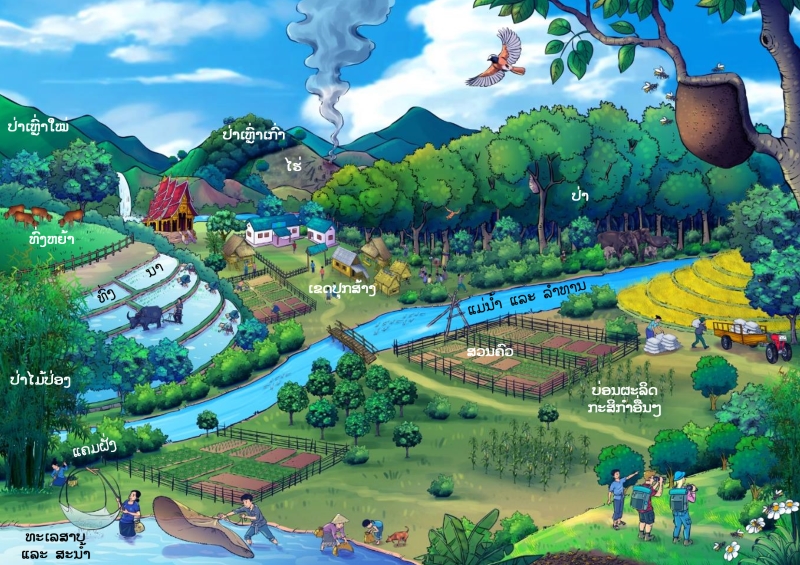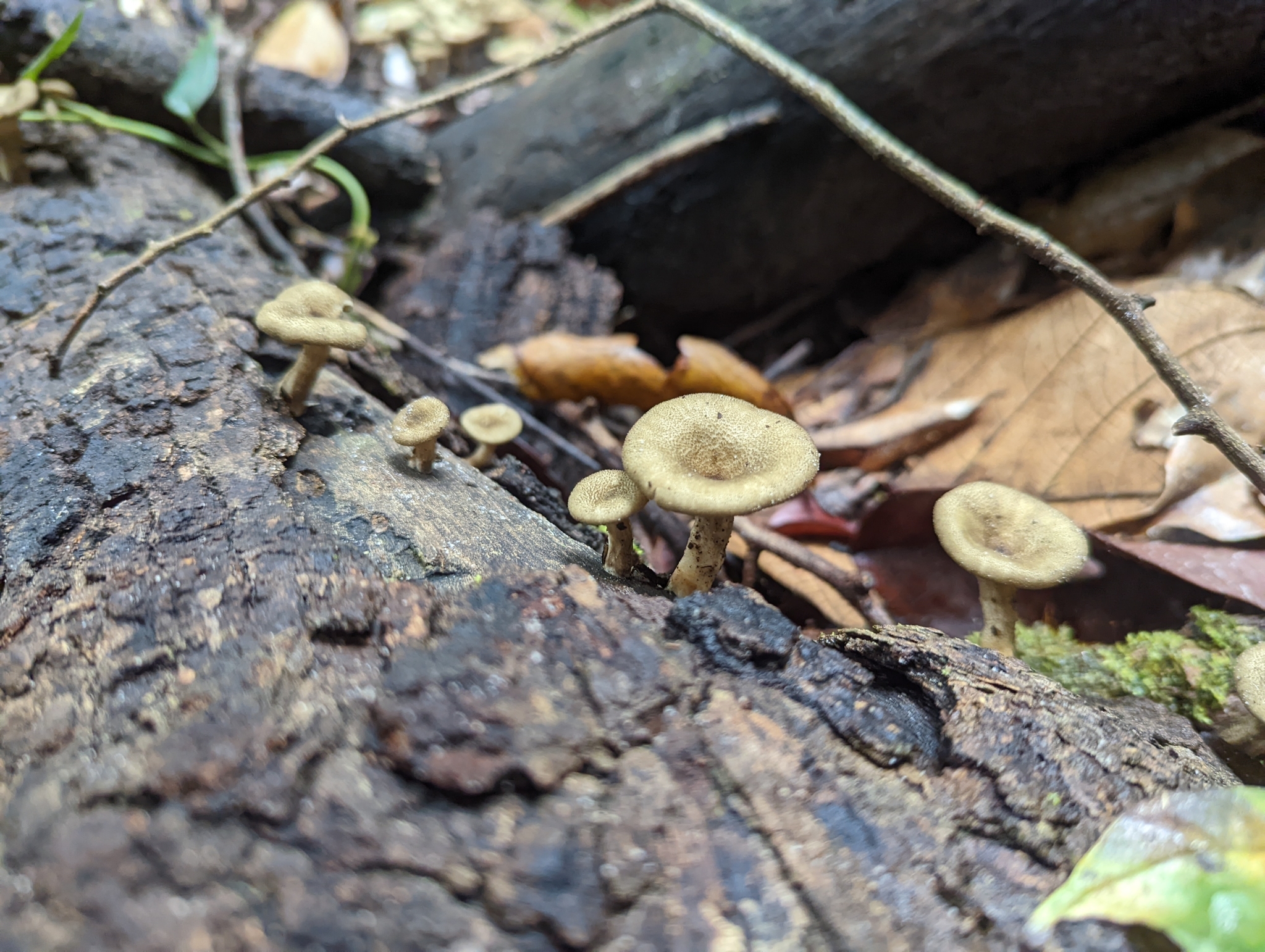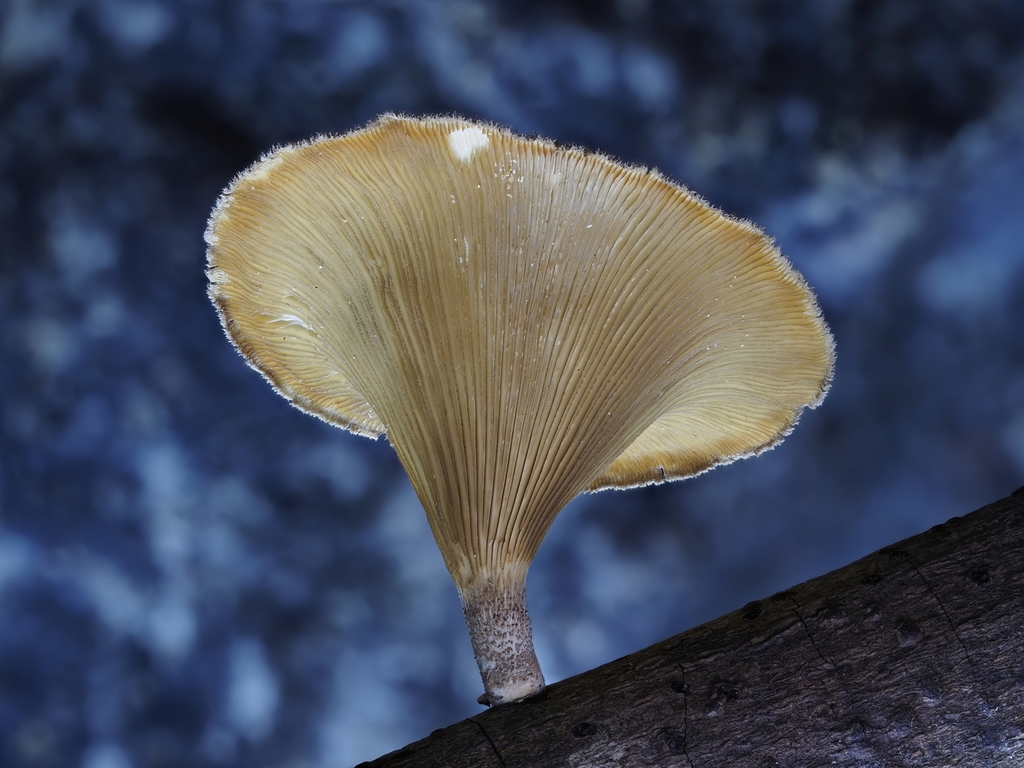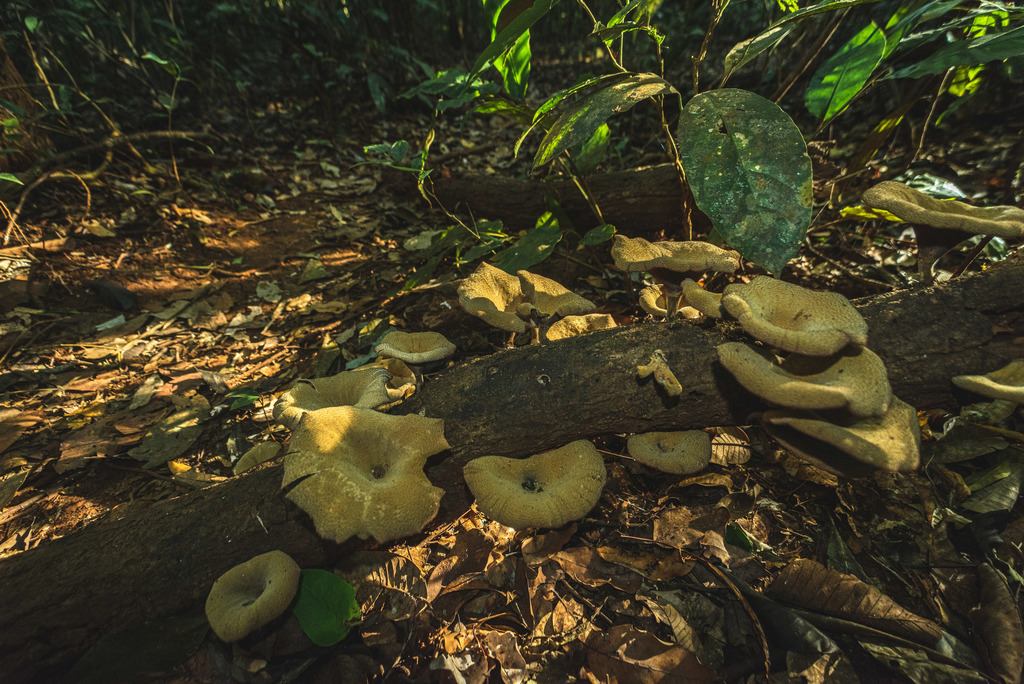ເລກລຳດັບທີ: 121
ລະດັບການຮວບຮວມຂໍ້ມູນ: ຂໍ້ມູນພື້ນຖານ
ປັບປູງຄັ້ງລ່າສຸດ: 2024-11-26
ເຫັດບົດ
Tiger Lentinus
Lentinus polychrous Lév.
ເຊື້ອເຫັດ
ເຊື້ອຣາທີ່ເກີດຕາມດິນ
×
ຊື່ທ້ອງຖີ່ນ:
ເຫັດກະດ້າງ
ຊື່ພ້ອງ
:
Lentinus estriatus Berk. & Broome
Lentinus eximius Berk. & Broome
Lentinus praerigidus Berk.
Lentinus sajor-caju var. polychrous (Lév.) Pilát
Panus polychrous (Lév.) Singer
Panus polychrous (Lév.) Singer ex Balf.-Browne=
Pocillaria estriata (Berk. & Broome) Kuntze
Pocillaria eximia (Berk. & Broome) Kuntze
Pocillaria polychroa (Lév.) Kuntze
Pocillaria praerigida (Berk.) Kuntze
Lentinus eximius Berk. & Broome
Lentinus praerigidus Berk.
Lentinus sajor-caju var. polychrous (Lév.) Pilát
Panus polychrous (Lév.) Singer
Panus polychrous (Lév.) Singer ex Balf.-Browne=
Pocillaria estriata (Berk. & Broome) Kuntze
Pocillaria eximia (Berk. & Broome) Kuntze
Pocillaria polychroa (Lév.) Kuntze
Pocillaria praerigida (Berk.) Kuntze
ຊື່ສະກຸນ:
Polyporaceae
ຊະນິດໃກ້ຄຽງ:
ເຫັດຂອນຂາວ/ White Log Mushroom
ເຫັດຫອມ/ Shiitake mushroom
ເຫັດຫອມ/ Shiitake mushroom
ບັນຍາຍລັກສະນະທາງພືດສາດ:
ເຫັດເຫຼົ່ານີ້ຂ້ອນຂ້າງແຂງ ແລະ ມີເກັດປົກຄຸມຢູ່ທົ່ວ. ເຫັດບົດມີຮູບຮ່າງເປັນຮູບຈວຍ ແລະ ມັກຈະອອກເປັນກຸ່ມຮຽງຊ້ອນກັນ. ໝວກເຫັດ (ເທິງສຸດ) ມີຂະໜາດປະມານ 50 ຫາ 150 ມມ, ສີນ້ຳຕານແດງ ຫາ ສີນໍ້າຕານປົນເຫຼືອງ. ບໍເວນກາງດອກມີລັກສະນະໂຄ້ງ ແລະ ມີສີເຂັ້ມກວ່າ. ກີບດອກ (ຟັນຟືມ) ແມ່ນເລິກ ແລະ ໜາແໜ້ນ, ມີສີຂີ້ເຖົ່າຫາສີນໍ້າຕານແດງຢູ່ບໍລິເວນປາຍກ້ານ. ຂອບດອກແສກແຂ້ວແເລື່ອຍລະອຽດ (ຮ່ອຍ). ກ້ານສັ້ນ, ເນື້ອສີຄີມຈືດຢູ່ບໍລິເວນກາງກ້ານຫາສ່ວນເທິ່ງ, ແລະ ເມື່ອຍັງອອກຈະມີແຜ່ນຄ້າຍເກັດ ຫຼັງຈາກນັ້ນຈະຄ່ອຍປ່ຽນເປັນສີເຂັ້ມ [3].
ນິເວດວິທະຍາ
ເຂດກະຈາຍພັນທົ່ວໂລກ:
Thailand, Malaysia, Lao, Viet Nam, Canada, Panama, America, Philippines, India, Nepal and Argentina
Global Distribution of the Tiger Lentinus between 2000 to 2022. Source: [4]
Global Distribution of the Tiger Lentinus between 2000 to 2022. Source: [4]
ເຂດກະຈາຍພັນໃນລາວ
:
ລຽບແມ່ນ້ຳຂອງພາກເໜືອ

ເຂດກະຈາຍພັນຕາມພູມສັນຖານ
:
ປ່າໂຄກ

ສະເພາະຖິ່ນໃນລາວ:
ພື້ນເມືອງ
ຮຸກຮານ
:
ບໍ່ຮຸກຮານ
ສະຖານະພາບການອະນູຮັກ IUCN
:
ບໍ່ມີຄວາມສ່ຽງ
ສະຖານະພາບການອະນຸຮັກແຫ່ງຊາດລາວ
:
ບໍ່ຖືກລະບຸໃນບັນຊີປະເພດໃດ
ການນຳໃຊ້
ປະເພດການນຳໃຊ້:
ອາຫານ
ພືດເປັນຢາ
ພືດເປັນຢາ
ບັນຍາຍການນຳໃຊ້:
ອາຫານ: ເຫັດບົດໃຊ້ປຸ່ງແຕ່ງອາຫານໄດ້ທົ່ວໄປໃນອາຊີຕາເວັນອອກສຽງໃຕ້ ລວມທັງປະເທດລາວ. ເຫັດຊະນິດນີ້ມີ ຣົດຊາດທີ່ເປັນເອກະລັກ ແລະ ໃຊ້ເປັນສ່ວນປະກອບຫຼັກຂອງອາຫານພື້ນເມືອງ ເຊັ່ນ: ແກງ ແລະ ຂົ້ວ. [3]
ຢາ: ເຫັດຊະນິດນີ້ມີສັກກະຍະພາບຊ່ວຍຫຼຸດລະດັບຄໍເຣສເຕີຣໍລ ແລະ ໄຕຣກຣີເຊີໄຣນ໌ ເນື່ອງຈາກມີ Eritadenine ເຊິ່ງເປັນສານທີ່ຊ່ວຍປ້ອງກັນພະຍາດຫົວໃຈ, ຄວາມດັນເລືອດສູງ, ແລະ ພະຍາດຕ່າງໆ ເຊັ່ນ: ພະຍາດເບົາຫວານ ແລະ HIV. ນອກຈາກນີ້, ມັນຍັງມີສັບພະຄຸນຊ່ວຍກະຕຸ້ນການປ້ອງກັນຕາມທໍາມະຊາດຂອງຮ່າງກາຍຕໍ່ກັບໂຣກມະເຮັງ, ສາມາດສົ່ງເສີມສຸຂະພາບຂອງຈຸລັງໂດຍລວມໄດ້ [8], [9].
ຢາ: ເຫັດຊະນິດນີ້ມີສັກກະຍະພາບຊ່ວຍຫຼຸດລະດັບຄໍເຣສເຕີຣໍລ ແລະ ໄຕຣກຣີເຊີໄຣນ໌ ເນື່ອງຈາກມີ Eritadenine ເຊິ່ງເປັນສານທີ່ຊ່ວຍປ້ອງກັນພະຍາດຫົວໃຈ, ຄວາມດັນເລືອດສູງ, ແລະ ພະຍາດຕ່າງໆ ເຊັ່ນ: ພະຍາດເບົາຫວານ ແລະ HIV. ນອກຈາກນີ້, ມັນຍັງມີສັບພະຄຸນຊ່ວຍກະຕຸ້ນການປ້ອງກັນຕາມທໍາມະຊາດຂອງຮ່າງກາຍຕໍ່ກັບໂຣກມະເຮັງ, ສາມາດສົ່ງເສີມສຸຂະພາບຂອງຈຸລັງໂດຍລວມໄດ້ [8], [9].
ການປູກ ການລ້ຽງ:
ປູກ ແລະ ທຳມະຊາດ
ລະດູການເກັບກູ້:
ມີນາ
ເມສາ
ພຶກສະພາ
ມິຖຸນາ
ກໍລະກົດ
ສິງຫາ
ກັນຍາ
ຕຸລາ
ເມສາ
ພຶກສະພາ
ມິຖຸນາ
ກໍລະກົດ
ສິງຫາ
ກັນຍາ
ຕຸລາ
ການຕະຫຼາດ ແລະ ຕ່ອງໂສ້ມູນຄ່າ:
ເຫັດບົດເປັນທີ່ນິຍົມຮັບປະທານກັນຫຼາຍໃນລາວ. ດັງນັ້ນ, ລາຄາຂອງເຫັດບົດຈຶ່ງຂ້ອນຂ້າງສູງກ່ວາເຫັດພື້ນເມືອງຊະນິດອື່ນ ຄື: 40,000 ຫາ 50,000 ກີບ ຕໍ່ກິໂລກຼາມ [13].
ການຄຸ້ມຄອງຈັດການ
ສະພາບໂດຍລວມ
ອຸນຫະພູມທີ່ເໝາະສົມ: ສາມາດປູກໃນເຮືອນບົ່ມເຊື້ອທີ່ມີອຸນຫະພູມລະຫວ່າງ 28 ຫາ 30 ອົງສາ [10].
ພື້ນທີ່ເໝາະສົມສຳຫຼັບການເພາະເຫັດ: ການເພາະເຫັດຊະນິດນີ້ ໃນໂຮງເຮືອນຄວນມີຂະໜາດກວ້າງປະມານ 4 ແມັດ, ຍາວ 6ແມັດ ແລະ ສູງ ປະມານ3 ແມັດ. ຫຼັງຄາຄວນຄຸມດ້ວຍຫຍ້າ, ດ້ານຂ້າງຄວນຄຸມດ້ວຍພຼາສຕິກທີ່ສາມາດເປີດຂື້ນໄດ້ງ່າຍ. [10]
ສະພາບດິນທີ່ໃຊ້ໃນການເພາະເຫັດ: ໂດຍທົ່ວໄປແລ້ວຈະໃຊ້ໄມ້ ຫຼື ຂໍ້ເລີຍປູກເປັນຫຼັກ. [10]
ການກຽມພື້ນທີ່:
ການກຽມວັດຖຸດິບ ແລະ ອຸປະກອນ: ມີຂີ້ເລື່ອຍອ່ອນ, ຮຳລະອຽດ, ປູນຂາວ, ນ້ຳຕານຊາຍ, ແລະ ເກືອ. [10]
ຂັ້ນຕອນການກະກຽມກ້ອນເຫັດ: ທໍາອິດ, ປະສົມຂີ້ເລື່ອຍກັບອາຫານເສີມແລ້ວຄົນໃຫ້ເຂົ້າກັນ ຈາກນັ້ນ, ຕື່ມນໍ້າເພື່ອໃຫ້ໄດ້ລະດັບຄວາມຊຸ່ມຊື່ນທີ່ຕ້ອງການ ແລ້ວບັນຈຸສ່ວນປະສົມດັ່ງກ່າວໃສ່ຖົງພຼາສຕິກທີ່ທົນທານຕໍ່ຄວາມຮ້ອນໃຫ້ແໜ້ນ ປະມານ 800 ກຣາມຕໍ່ຖົງ. ມັດຖົງພຼາສຕິກໂດຍໃສ່ຄໍຂວດ ແລະ ປິດຝາໃຫ້ແໜ້ນ. ສຸດທ້າຍນໄປນຶ້ງຂ້າເຊື້ອທີ່ອຸນຫະພູມ 100 ອົງສາ ເປັນເວລາ 2 ຊົ່ວໂມງ. ຈາກນັ້ນ, ເຂ່ຍຫົວເຊື້ອ (ຈຸລິນຊີທີ່ນໍາມາໃຊ້ໃນການຫມັກ), ປະມານ 10-20 ເມັດຕໍ່ຖົງ. [10], [11]
ເທັກນິກການປູກ:
ຫຼັງຈາກເຂ່ຍຫົວເຊື້ອເຫັດແລ້ວ, ຈະບົ່ມເຫັດເປັນເວລາ 25 ຫາ 30 ມື້ ໃນໄລຍະນີ້ເສັ້ນໃຍໄມຊີລຽມຈະຄ່ອຍໆຂະຫຍາຍຂື້ນເລືອຍໆ ຈົນເຕັມຖົງພຼາສຕິກ, ເຊິ່ງສະແດງໃຫ້ເຫັນເຖິ່ງການຈະເລີນເຕີບໂຕ ແລະ ມີສຸຂະພາບທີ່ດີ. ເມື່ອເສັ້ນໃຍຂະຫຍາຍເຕັມທີ່ແລ້ວກໍສາມາດຍ້າຍໄປໂຮງເຮືອນທີ່ກຽມໄວ້ເພື່ອເປີດດອກ [10].
ການເບິ່ງແຍງ ແລະ ບຳລຸງຮັກສາ:
ການຫົດນໍ້າ: ເພື່ອເລີ່ມການເປີດອກເຫັດ ໃຫ້ເລີ່ມຈາກການເປີດຝາອອກ ແລະ ຮັກສາຄວາມຊຸ່ມໃຫ້ເໝາະສົມໂດຍການຫົດນໍ້າຕາມຄວາມຈຳເປັນ. ຫຼັງຈາກເກັບຫັດແລ້ວ ບໍ່ໃຫ້ຫົດນ້ຳທັນທີ ປ່ອຍປະໄວ້ປະມານ 7 ຫາ 10 ມື້ ຈາກນັ້ນ, ຈຶ່ງໃຫ້ນ້ຳອີກຄັ້ງ ໂດຍຄວບຄຸມອຸນຫະພູມໃຫ້ຢູ່ປະມານ 30 ຫາ 40 ອົງສາ, ວິທີນີ້ຈະຊ່ວຍເຮັດໃຫ້ເຫັດເຕີບໂຕ ແລະ ອອກດອກໄວ. ເມື່ອເຫັດບານເຕັມທີ່ແລ້ວ ຄວນເປີດພລາສຕິກອອກເພື່ອໃຫ້ມີອາກາດຖ່າຍເທສະດວກ [10].
ການຄວບຄຸມແສງ: ໃຫ້ເຫັດຈະເລີນເຕີບໂຕປະມານ 7 ຫາ 10 ມື້ ເຊິ່ງຈະເຫັນໄດ້ຊັດເຈນວ່າມີຕຸ່ມນ້ອຍໆບໍລິເວນປາກຖົງເຫັດ, ສະແດງວ່າມີການລະບາຍອາກາດຢ່າງເໝາະສົມ ໂດຍຈະເປີດດ້ານຂ້າງຂອງໂຮງເຮືອນເຫັດ ຫາດູແລຢ່າງເໝາະສົມເຫັດຈະບານເຕັມທີພາຍໃນ 1 ຫາ 2 ເດືອນ [10].
ການເກັບກ່ຽວ:
ການເກັບເຫັດແມ່ນສາມາດເກັບສອງຄັ້ງຕໍ່ມື້, ເກັບທັງຕອນເຊົ້າແລະຕອນແລງ, ໃນການເກັບໃຊ້ມືຂອງເຮົາບີດດອກເຫັດຄ່ອຍໆ. ເລືອກເອົາພຽງແຕ່ເຫັດທີ່ອອກດອກເຕັມໂຕແລ້ວ. [10]
ການອານຸລັກທີ່ຢູ່ອາໄສ:
ໜ້າເສຍດາຍທີ່ຈຳນວນປະຊາກອນຂອງເຫັດຊະນິດນີ້ ກຳລັງຫຼຸດລົງຢ່າງຕໍ່ເນື່ອງ ຈາກການປ່ຽນແປງຂອງສະພາບແວດລ້ອມ ແລະ ການຈຕັດໄມ້ທຳລາຍປ່າ [8].
ການເກັບກູ້ແບບຍືຍຍົງ:
ພວກເຮົາຄວນສຶກສາເຫັດ ໃນຫຼຍໆດ້ານ ເຊັ່ນ: ລັກສະນະທາງດ້ານສັນຖານວິທະຍາ, ພາບແວດລ້ອມ ແລະ ໄລຍະການອອກດອກ. ນອກຈາກນີ້, ສິ່ງສຳຄັນຄື ການຮຽນຮູ້ກ່ຽວກັບທ່ອນໄມ້ທີ່ເໝາະສົມຕໍ່ການຈະເລີນເຕີບໂຕ ແລະ ມີສ່ວນຊ່ວຍໃນການອານຸລັກເຫັດຊະນິດນີ້ ວິທີການນີ້ຈະຊ່ວຍເປີດໂອກາດໃຫ້ຊາວບ້ານສາມາດເພາະເຫັດໄດ້ເອງ ໂດຍບໍ່ຕ້ອງທຳລາຍປ່າໄມ້ [8].
ອຸນຫະພູມທີ່ເໝາະສົມ: ສາມາດປູກໃນເຮືອນບົ່ມເຊື້ອທີ່ມີອຸນຫະພູມລະຫວ່າງ 28 ຫາ 30 ອົງສາ [10].
ພື້ນທີ່ເໝາະສົມສຳຫຼັບການເພາະເຫັດ: ການເພາະເຫັດຊະນິດນີ້ ໃນໂຮງເຮືອນຄວນມີຂະໜາດກວ້າງປະມານ 4 ແມັດ, ຍາວ 6ແມັດ ແລະ ສູງ ປະມານ3 ແມັດ. ຫຼັງຄາຄວນຄຸມດ້ວຍຫຍ້າ, ດ້ານຂ້າງຄວນຄຸມດ້ວຍພຼາສຕິກທີ່ສາມາດເປີດຂື້ນໄດ້ງ່າຍ. [10]
ສະພາບດິນທີ່ໃຊ້ໃນການເພາະເຫັດ: ໂດຍທົ່ວໄປແລ້ວຈະໃຊ້ໄມ້ ຫຼື ຂໍ້ເລີຍປູກເປັນຫຼັກ. [10]
ການກຽມພື້ນທີ່:
ການກຽມວັດຖຸດິບ ແລະ ອຸປະກອນ: ມີຂີ້ເລື່ອຍອ່ອນ, ຮຳລະອຽດ, ປູນຂາວ, ນ້ຳຕານຊາຍ, ແລະ ເກືອ. [10]
ຂັ້ນຕອນການກະກຽມກ້ອນເຫັດ: ທໍາອິດ, ປະສົມຂີ້ເລື່ອຍກັບອາຫານເສີມແລ້ວຄົນໃຫ້ເຂົ້າກັນ ຈາກນັ້ນ, ຕື່ມນໍ້າເພື່ອໃຫ້ໄດ້ລະດັບຄວາມຊຸ່ມຊື່ນທີ່ຕ້ອງການ ແລ້ວບັນຈຸສ່ວນປະສົມດັ່ງກ່າວໃສ່ຖົງພຼາສຕິກທີ່ທົນທານຕໍ່ຄວາມຮ້ອນໃຫ້ແໜ້ນ ປະມານ 800 ກຣາມຕໍ່ຖົງ. ມັດຖົງພຼາສຕິກໂດຍໃສ່ຄໍຂວດ ແລະ ປິດຝາໃຫ້ແໜ້ນ. ສຸດທ້າຍນໄປນຶ້ງຂ້າເຊື້ອທີ່ອຸນຫະພູມ 100 ອົງສາ ເປັນເວລາ 2 ຊົ່ວໂມງ. ຈາກນັ້ນ, ເຂ່ຍຫົວເຊື້ອ (ຈຸລິນຊີທີ່ນໍາມາໃຊ້ໃນການຫມັກ), ປະມານ 10-20 ເມັດຕໍ່ຖົງ. [10], [11]
ເທັກນິກການປູກ:
ຫຼັງຈາກເຂ່ຍຫົວເຊື້ອເຫັດແລ້ວ, ຈະບົ່ມເຫັດເປັນເວລາ 25 ຫາ 30 ມື້ ໃນໄລຍະນີ້ເສັ້ນໃຍໄມຊີລຽມຈະຄ່ອຍໆຂະຫຍາຍຂື້ນເລືອຍໆ ຈົນເຕັມຖົງພຼາສຕິກ, ເຊິ່ງສະແດງໃຫ້ເຫັນເຖິ່ງການຈະເລີນເຕີບໂຕ ແລະ ມີສຸຂະພາບທີ່ດີ. ເມື່ອເສັ້ນໃຍຂະຫຍາຍເຕັມທີ່ແລ້ວກໍສາມາດຍ້າຍໄປໂຮງເຮືອນທີ່ກຽມໄວ້ເພື່ອເປີດດອກ [10].
ການເບິ່ງແຍງ ແລະ ບຳລຸງຮັກສາ:
ການຫົດນໍ້າ: ເພື່ອເລີ່ມການເປີດອກເຫັດ ໃຫ້ເລີ່ມຈາກການເປີດຝາອອກ ແລະ ຮັກສາຄວາມຊຸ່ມໃຫ້ເໝາະສົມໂດຍການຫົດນໍ້າຕາມຄວາມຈຳເປັນ. ຫຼັງຈາກເກັບຫັດແລ້ວ ບໍ່ໃຫ້ຫົດນ້ຳທັນທີ ປ່ອຍປະໄວ້ປະມານ 7 ຫາ 10 ມື້ ຈາກນັ້ນ, ຈຶ່ງໃຫ້ນ້ຳອີກຄັ້ງ ໂດຍຄວບຄຸມອຸນຫະພູມໃຫ້ຢູ່ປະມານ 30 ຫາ 40 ອົງສາ, ວິທີນີ້ຈະຊ່ວຍເຮັດໃຫ້ເຫັດເຕີບໂຕ ແລະ ອອກດອກໄວ. ເມື່ອເຫັດບານເຕັມທີ່ແລ້ວ ຄວນເປີດພລາສຕິກອອກເພື່ອໃຫ້ມີອາກາດຖ່າຍເທສະດວກ [10].
ການຄວບຄຸມແສງ: ໃຫ້ເຫັດຈະເລີນເຕີບໂຕປະມານ 7 ຫາ 10 ມື້ ເຊິ່ງຈະເຫັນໄດ້ຊັດເຈນວ່າມີຕຸ່ມນ້ອຍໆບໍລິເວນປາກຖົງເຫັດ, ສະແດງວ່າມີການລະບາຍອາກາດຢ່າງເໝາະສົມ ໂດຍຈະເປີດດ້ານຂ້າງຂອງໂຮງເຮືອນເຫັດ ຫາດູແລຢ່າງເໝາະສົມເຫັດຈະບານເຕັມທີພາຍໃນ 1 ຫາ 2 ເດືອນ [10].
ການເກັບກ່ຽວ:
ການເກັບເຫັດແມ່ນສາມາດເກັບສອງຄັ້ງຕໍ່ມື້, ເກັບທັງຕອນເຊົ້າແລະຕອນແລງ, ໃນການເກັບໃຊ້ມືຂອງເຮົາບີດດອກເຫັດຄ່ອຍໆ. ເລືອກເອົາພຽງແຕ່ເຫັດທີ່ອອກດອກເຕັມໂຕແລ້ວ. [10]
ການອານຸລັກທີ່ຢູ່ອາໄສ:
ໜ້າເສຍດາຍທີ່ຈຳນວນປະຊາກອນຂອງເຫັດຊະນິດນີ້ ກຳລັງຫຼຸດລົງຢ່າງຕໍ່ເນື່ອງ ຈາກການປ່ຽນແປງຂອງສະພາບແວດລ້ອມ ແລະ ການຈຕັດໄມ້ທຳລາຍປ່າ [8].
ການເກັບກູ້ແບບຍືຍຍົງ:
ພວກເຮົາຄວນສຶກສາເຫັດ ໃນຫຼຍໆດ້ານ ເຊັ່ນ: ລັກສະນະທາງດ້ານສັນຖານວິທະຍາ, ພາບແວດລ້ອມ ແລະ ໄລຍະການອອກດອກ. ນອກຈາກນີ້, ສິ່ງສຳຄັນຄື ການຮຽນຮູ້ກ່ຽວກັບທ່ອນໄມ້ທີ່ເໝາະສົມຕໍ່ການຈະເລີນເຕີບໂຕ ແລະ ມີສ່ວນຊ່ວຍໃນການອານຸລັກເຫັດຊະນິດນີ້ ວິທີການນີ້ຈະຊ່ວຍເປີດໂອກາດໃຫ້ຊາວບ້ານສາມາດເພາະເຫັດໄດ້ເອງ ໂດຍບໍ່ຕ້ອງທຳລາຍປ່າໄມ້ [8].
ໂພຊະນາການ
ຄຸນຄ່າທາງໂພຊະນາການ:
ບັນຍາຍຄຸນຄ່າທາງໂພຊະນາການ:
N/A
| ສານອາຫານ | /100g | ໝາຍເຫດ |
|---|---|---|
| ໂປຣຕີນ | N/A | N/A |
| ຄາໂບໄຮເດຣດ | N/A | N/A |
| ໄຂມັນ | N/A | N/A |
| ວິຕາມິນ | N/A | N/A |
| ແຮ່ທາດ | N/A | N/A |
| ເສັ້ນໄຍ | N/A | N/A |
ອ້າງອິງ
ເຄດິດຮູບພາບ:
Tiger Lentinus fully expanded. [1] iNaturalist [Online]. Uploaded on 5 April 2022 by: jackychiangmai. Available: www.inaturalist.org/observations/110461994. [Ac-cessed: 24 September 2024]
Tiger Lentinus growing from a tree trunk. [2] iNaturalist [Online]. Uploaded on 28 August 2022 by: calebcatto. Available: www.inaturalist.org/observations/132565119. [Ac-cessed: 24 September 2024]
Tiger Lentinus from above. [3] T. Læssøe and O. Pedersen, “An Introduction to the Edible, Poisonous and Medicinal Fungi of Northern Laos”. Vientiane: FAO Repre-sentative to Lao PDR, 2018
Tiger Lentinus growing from a tree trunk. [2] iNaturalist [Online]. Uploaded on 28 August 2022 by: calebcatto. Available: www.inaturalist.org/observations/132565119. [Ac-cessed: 24 September 2024]
Tiger Lentinus from above. [3] T. Læssøe and O. Pedersen, “An Introduction to the Edible, Poisonous and Medicinal Fungi of Northern Laos”. Vientiane: FAO Repre-sentative to Lao PDR, 2018
ອ້າງອິງ:
[4] Global Biodiversity Information Facility (GBIF), “Lentinus polychrous Lév.” [Online]. Available: https://www.gbif.org/species/2545452. [Accessed: 24 September 2024].
[5] P. Sysouphanthong, W. Taliam, N. Wannasawang, and N. Thongklang, "The genus Lentinus in Thailand: taxonomy, cultivation tests, nu-tritional analysis and screening for the biological activity of wild strains," Current Research in Environmental & Applied Mycology, vol. 13, no. 1, pp. 136-161, 2023.
[6] P. E. Mortimer, J. Xu, S. C. Karunarathna, and K. D. Hyde, “Mush-rooms for Trees and People: A Field Guide to Useful Mushrooms of the Mekong Region”. Kunming, China: The World Agroforestry Centre (ICRAF), 2014.
[7] IUCN, “IUCN Red List,” [Online]. Available: https://redlist.info/iucn/species_view/197977/. [Accessed: 04 Ju-ly 2024].
[8] S. Rattanamalee and C. Rattanamalee, "The Biology of Lentinus poly-chrous Lev. in Nakhon Phanom Province, Thailand and Kwaeng Kham Muan, Laos," IJERD – International Journal of Environmen-tal and Rural Development, vol. 3, no. 2, pp. 1-10, 2012.
[9] N. Fangkrathok, "Chemical Constituents and Pharmacological Activi-ties of Lentinus polychrous Lév." ว. เภสัชศาสตร์อีสาน, vol. 1, pp. 49-57, 2019.
[10] ສຸດທະສາດ, ກ. & ຄະນະ. "ບົດລາຍງານການປູກເຫັດ ເຫັດບົດ," ນະຄອນຫຼວງວຽງຈັນ, ຄະນະວິທະສາດສິ່ງແວດລ້ອມ, 2011.
[11] P. Mortimer, “Mushrooms for Trees and People: A Field Guide to Useful Mushrooms of the Mekong Region”, Kunming, China: The World Agroforestry Centre (ICRAF), 2014.
[12] ทองเอกแก้ว, จ. "Nutritive value of Hed Kradang (Lentinus polychrous Lév.)," Ubon Rajathanee, 2003.
[13] "ເຫັດບົດ" Suansanam Famring, [Online]. Available: https://suansanamfamring.blogspot.com/p/blog-page_8.html. [Accessed: Oct. 8, 2024].
[5] P. Sysouphanthong, W. Taliam, N. Wannasawang, and N. Thongklang, "The genus Lentinus in Thailand: taxonomy, cultivation tests, nu-tritional analysis and screening for the biological activity of wild strains," Current Research in Environmental & Applied Mycology, vol. 13, no. 1, pp. 136-161, 2023.
[6] P. E. Mortimer, J. Xu, S. C. Karunarathna, and K. D. Hyde, “Mush-rooms for Trees and People: A Field Guide to Useful Mushrooms of the Mekong Region”. Kunming, China: The World Agroforestry Centre (ICRAF), 2014.
[7] IUCN, “IUCN Red List,” [Online]. Available: https://redlist.info/iucn/species_view/197977/. [Accessed: 04 Ju-ly 2024].
[8] S. Rattanamalee and C. Rattanamalee, "The Biology of Lentinus poly-chrous Lev. in Nakhon Phanom Province, Thailand and Kwaeng Kham Muan, Laos," IJERD – International Journal of Environmen-tal and Rural Development, vol. 3, no. 2, pp. 1-10, 2012.
[9] N. Fangkrathok, "Chemical Constituents and Pharmacological Activi-ties of Lentinus polychrous Lév." ว. เภสัชศาสตร์อีสาน, vol. 1, pp. 49-57, 2019.
[10] ສຸດທະສາດ, ກ. & ຄະນະ. "ບົດລາຍງານການປູກເຫັດ ເຫັດບົດ," ນະຄອນຫຼວງວຽງຈັນ, ຄະນະວິທະສາດສິ່ງແວດລ້ອມ, 2011.
[11] P. Mortimer, “Mushrooms for Trees and People: A Field Guide to Useful Mushrooms of the Mekong Region”, Kunming, China: The World Agroforestry Centre (ICRAF), 2014.
[12] ทองเอกแก้ว, จ. "Nutritive value of Hed Kradang (Lentinus polychrous Lév.)," Ubon Rajathanee, 2003.
[13] "ເຫັດບົດ" Suansanam Famring, [Online]. Available: https://suansanamfamring.blogspot.com/p/blog-page_8.html. [Accessed: Oct. 8, 2024].
ຜູ້ສ້າງ Factsheet:
ຜູ້ກວດສອບ Factsheet:
,


